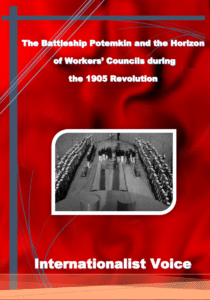The Battleship Potemkin and the Horizon of Workers’ Councils during the 1905 Revolution
The Russo-Japanese War, together with an economic and social crisis, created the conditions for the 1905 Russian Revolution. During this uprising, widespread strikes and rebellions by workers and sailors drew millions into protest. One of the most significant outcomes of the 1905 Revolution was the emergence of a new form of workers’ organisation: the workers’ councils. These councils, as a novel form of proletarian organisation, were particularly important, for they acted as the embryo of working-class power; in other words, the material conditions for the working class to achieve political power were beginning to be established.
During the 1905 Revolution, a wave of strikes and workers’ uprisings swept across Russia. One of the most notable of these was the uprising of the sailors of the battleship Potemkin in June of that year, recognised as one of the first signs of the awakening of the working class and the sailors.[1] The spark for the rebellion came when the sailors were given spoiled food, which they refused to eat. This act was considered a serious case of insubordination and provoked a harsh response from the officers. The officers resorted to the naval guard to suppress the uprising, but during the ensuing clash, one of the revolt’s leaders, Grigory Vakulenchuk, was killed.
Afterwards, the sailors of the Potemkin formed a “workers’ committee” to manage the ship, hoisted the red flag, and set out for Odessa to join the urban strikes. Vakulenchuk’s grand funeral in the city turned into a massive demonstration, drawing thousands onto the streets. The response of the Tsarist army, however, was a bloody crackdown: soldiers from the top of Odessa’s famous steps and Cossacks from below opened fire on the demonstrators, unleashing a veritable bloodbath.
The sailors of the Potemkin attempted to gain the support of other fleets as well, but since sufficient backing was not forthcoming, the ship set out into the open sea. Eventually, due to a shortage of water and coal, it took refuge in a port in Romania. The Romanian government refrained from providing any direct assistance but offered, if the battleship were handed over, to grant the crew political asylum—a proposal that was ultimately accepted. Nevertheless, many of the participants were later arrested, tried, and sentenced to execution or exile. Among them, Afanasi Matushenko, one of the leaders of the revolt, was arrested by the imperial authorities in 1907 and executed.
The Potemkin uprising, although ultimately completely suppressed, was recorded in history as an important and enduring moment in the 1905 Russian Revolution. The significance of this revolt lay not in its military dimension, but in its class character. Soldiers and sailors, who themselves were part of the proletariat, rebelled against the inhumane conditions and the oppression of the commanders and the authorities. By challenging hierarchical authority and defying blind obedience, they demonstrated that sailors could independently manage a battleship, and that the ship could, rather than serving the ruling class, serve the working-class movement.
The historical significance of the Potemkin uprising lies not in its military dimension, but in its political and class perspective, for it revealed, like a spark, the possibility of rebellion within the military structure. Nevertheless, despite its acts of heroism and bravery, the uprising also exposed its own limitations. The absence of a widespread proletarian movement at the time confined the revolt to a single ship and a specific moment. Moreover, the lack of an organised link with workers’ councils and strike movements prevented it from rising above the level of a mere insurrection. Efforts to establish such a connection in Odessa also failed, further isolating the uprising.
For this reason, the Potemkin uprising clearly demonstrated that spontaneous anger, however heroic, is insufficient on its own to overthrow bourgeois power. Only through independent organisation and the revolutionary consciousness of the working class, together with the establishment of an organic link between the struggles of workers, soldiers, and peasants within a broad, revolutionary framework, does the possibility arise to seize political power and dismantle the bourgeois state apparatus.
The 1905 Revolution progressed through a cycle of workers’ strikes, urban uprisings, sailors’ and peasants’ rebellions, and the emergence of workers’ councils. The most prominent of these councils was the Petersburg Workers’ Council, established in October of the same year. Although the revolution ultimately failed, and from a dialectical perspective could not have progressed beyond what it achieved at the time, the historical and material conditions were not yet fully in place. These conditions were later created in the context of the First World War—a conflict that demonstrated that capitalism had entered its stage of decline and that the objective conditions for the working class to seize political power had been established.
Nevertheless, even the failure of the 1905 Revolution brought significant historical achievements. The councils, as organs of dual power, became a historical instrument for the working class to exercise power and provided a new experience of political organisation. From this perspective, the 1905 Revolution served as a kind of rehearsal for the October Revolution of 1917. From the Potemkin uprising to the widespread strikes and the formation of workers’ councils, the experiences of this revolution illuminated the prospects for future struggles of the proletariat and laid the material and political foundations for the 1917 Revolution.
M.J.
1 October 2025
Note:
[1] The film Battleship Potemkin is well worth watching and comes highly recommended. You can watch the film via this link.















